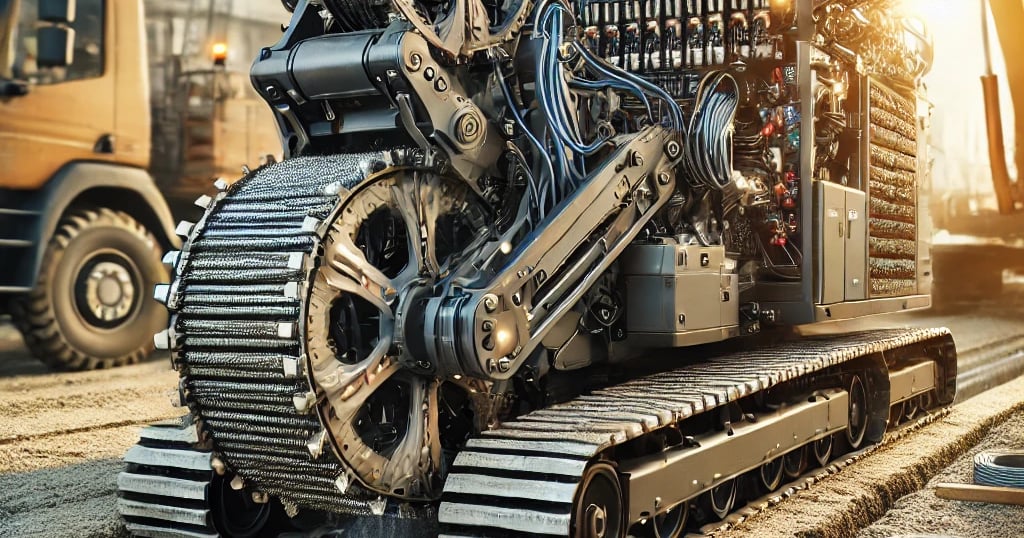Burying Power Lines: Where CSR Challenges and Technical Performance Converge
You won’t hear about it in the news, but a quiet technical and financial revolution is underway in the construction industry, driven by Enedis and other key players. The undergrounding of power lines is both a technical breakthrough and a Corporate Social Responsibility (CSR) challenge—one that is reshaping the energy landscape.
VEILLE ECONOMIQUERSE
LYDIE GOYENETCHE
1/4/20253 min read


Market Overview: Burying Power Lines – Concealing the Past to Reveal the Future
Burying the Past to Illuminate the Future
Burying power lines isn’t just about cables and trenches—it’s a silent revolution. With nearly 47% of France’s power network already underground, according to Enedis, the country is leading the charge. Spain, where about 30% of lines are buried, is moving at its own pace, focusing on strategic innovations.
Across Europe, as the energy transition accelerates, undergrounding power infrastructure is no longer an option—it’s a necessity. But the economic and technical challenges remain steep: how can costs—ranging from €80,000 to €120,000 per kilometer—be reduced while meeting the growing demands of municipalities, utility companies, and citizens?
The Hidden Challenges of Undergrounding Power Lines
Sky-High Costs
Burying a kilometer of medium-voltage power lines represents a massive investment. In France alone, Enedis spent €1.3 billion in 2022 to modernize its grid, with a significant portion dedicated to undergrounding. The utility aims to have 70% of lines buried in high-risk areas by 2030.
Cutting-Edge Technology
Companies like Marais Group, a subsidiary of Tesmec, are revolutionizing the industry with automated trenching machines. These advanced tools dramatically reduce installation time and environmental impact, making it possible to bury up to 1 km of power lines per day under optimal conditions.
Environmental Protection
Undergrounding power lines isn’t just about aesthetics—it’s about resilience. It minimizes disruptions caused by extreme weather events. According to France’s Ministry of Ecological Transition, storms caused €1.6 billion in damages between 2000 and 2020. By burying power lines, the risk of outages and costly repairs is significantly reduced.
Europe’s Push for Standardization
The European Union has established strict safety and interoperability standards through CENELEC, ensuring that infrastructure upgrades are seamless across borders.
One standout example of cross-border collaboration is the France-Spain HVDC Baixas-Santa Llogaia interconnection, managed by RTE and Red Eléctrica. This 64.5-km underground power link transmits up to 2,000 MW of electricity, reducing energy losses by 30% compared to conventional overhead lines.
Spain is also investing heavily in its grid. Red Eléctrica has allocated €4.4 billion between 2021 and 2026 to modernize and expand underground power networks.
What the Future Holds: A Revolution Beneath the Surface
The market outlook is promising. In France, the France Recovery Plan is injecting €100 million into strengthening electricity networks, particularly in rural areas. In Spain, similar initiatives are fostering the adoption of innovative technologies like self-healing cables, developed by Prysmian Group.
Advanced monitoring systems, such as those provided by Schneider Electric, allow for real-time tracking of infrastructure conditions. These solutions reduce maintenance costs by 20–30% while extending the lifespan of power networks.
However, challenges persist. Regulatory delays and complex negotiations between municipalities, energy syndicates, and grid operators continue to slow progress. The key to success lies in stronger public-private partnerships and streamlined coordination.
Beyond the Surface: The Strategy Behind Undergrounding
The success of underground power projects hinges on smart financing and clear communication. Enedis and RTE, the key players in France, are working closely with local governments to prioritize high-risk areas. In Spain, Red Eléctrica follows a similar approach, targeting regions prone to climate hazards.
Investing in research and development is also crucial. Innovations like GE Grid Solutions’ intelligent monitoring systems, which detect network anomalies in real time, are reshaping the industry. These technologies enable proactive maintenance and optimal resource allocation.
Conclusion: A Buried Opportunity Waiting to Surface
Undergrounding power lines is more than just an engineering challenge—it’s a strategic opportunity to modernize infrastructure, enhance energy resilience, and meet societal expectations.
With a clear vision and strong industry leadership from Enedis, Red Eléctrica, and Prysmian Group, underground power grids have the potential to turn technical and financial challenges into levers for sustainable growth.
Now is the time for forward-thinking companies to step up. Seize this opportunity to innovate, invest, and shape a future where energy flows safely and seamlessly—hidden underground, but at the very heart of our daily lives.


EUSKAL CONSEIL
0033782505766
euskalconseil@gmail.com
This website uses only Plausible Analytics, a privacy-friendly web analytics tool.
No cookies are used, and no personal data is collected from visitors.
The system is fully compliant with the General Data Protection Regulation (GDPR), the ePrivacy Directive, and CNIL recommendations.
You can read more about Plausible’s data policy here: https://plausible.io/data-policy